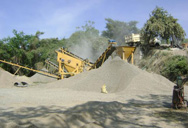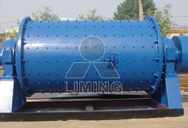


1994-5-1 When minerals have very similar susceptibilities, or similar magnetic moments in the presence of a field, other magnetic properties may be exploitable to achieve selective separation. Two species with different coercive forces may be separated by applying an alternating magnetic field, with peak value below the coercivity of one mineral and ...
Read More
2002-2-13 Magnetic separation takes advantage of differences in the magnetic properties of minerals. Minerals fall into one of three magnetic properties: ferromagnetic, paramagnetic and diamagnetic. Ferromagnetic minerals are themselves magnetic (i.e., magnetite and pyrrhotite) and can be easily separated from other minerals with a magnet since they will stick to the poles of the magnet.
Read More
1992-3-1 The Frantz Isodynamic, introduced in the early 1930s, is the most efficient magnetic separator for the discrimination of minerals with fieldindependent magnetic susceptibilities. The isodynamic field, generated by a bipolar magnet with special pole tip profiles, provides the constancy of the product of the field and the field gradient.
Read More
Magnetic separation of minerals is a topic that is seldom reported in the literature for two reasons. First, separation data generally are byproducts of other projects; and second, this study requires a large amount of patience and is unusually tedious. Indeed, we suspect that most minerals probably are never investigated for this property.
Read More
Magnetic separation of minerals utilizing magnetic particulates . United States Patent 4219408 . Abstract: A method for magnetically beneficiating an ore by removing therefrom undesired metallic minerals of inherently low magnetic attractability. An aqueous dispersed slurry of the ore is formed, and the slurry is mixed with a system of ...
Read More
2016-12-4 4 MAGNETIC SEPARATION OF SULPHIDE MINERALS range of variation in susceptibility demon- strated by the various sulphides. COPPER-FLOTATION PLANTS Macuchi, Ecuador At the mill of the Cotopaxi Exploration Co., Macuchi, Ecuador, the principal minerals are chalcopyrite, pyrite, barite, and quartz. The ore contains considerable
Read More
2014-7-1 Many RE minerals are found alongside low specific gravity gangue minerals thereby permitting the use of gravity separations to concentrate the heavy value RE minerals. Magnetic separation is used primarily to remove ferromagnetic gangue minerals as well as to separate individual paramagnetic rare earth minerals.
Read More
2018-9-6 magnetic separation. The application of SEM-based image analysis data to magnetic separation was inter alia carried out by Leißner et al. (2016b) [15]. The magnetic susceptibility of different minerals is one major determining parameter influencing the results of magnetic separation. The iron content in minerals shows a big
Read More
Magnetic separation is often considered pertinent for manganese ore beneficiation when the ore is abundant with siliceous rich gangue mineral phases. However, the process is deemed to be inapposite for the ferruginous type of ore, and remains a grey area of research.
Read More
2020-1-10 NOTE: With the development of magnetic separation technology, the boundary between weak magnetic minerals and non-magnetic minerals will change. The lower limit of the magnetization coefficient of weak magnetic minerals is decreasing, which is the inevitable trend of the development of magnetic separation.
Read More
1994-5-1 When minerals have very similar susceptibilities, or similar magnetic moments in the presence of a field, other magnetic properties may be exploitable to achieve selective separation. Two species with different coercive forces may be separated by applying an alternating magnetic field, with peak value below the coercivity of one mineral and ...
Read More
1992-3-1 Powder Technology, 69 (1992) 279-284 Separation of minerals by selective magnetic fluidization U. Andres Department of Mineral Resources Engineering, Imperial College of Science, Technology and Medicine, London SW7 2BP (UK) and W. O'Reilly Department of Physics, University of Newcastle upon Tyne, Newcastle upon Tyne NEI 7RU (UK) (Received April 15, 1991; in revised form
Read More
Magnetic separation of minerals is a topic that is seldom reported in the literature for two reasons. First, separation data generally are byproducts of other projects; and second, this study requires a large amount of patience and is unusually tedious. Indeed, we suspect that most minerals probably are never investigated for this property.
Read More
2021-5-25 The rare earth magnetic separator range achieves the most effective dry separation of paramagnetic minerals at high throughput rates. The range includes Rare Earth Roll (RERS) and Rare Earth Drum (REDS) Separators which are available in a
Read More
Magnetic separation of minerals utilizing magnetic particulates . United States Patent 4219408 . Abstract: A method for magnetically beneficiating an ore by removing therefrom undesired metallic minerals of inherently low magnetic attractability. An aqueous dispersed slurry of the ore is formed, and the slurry is mixed with a system of ...
Read More
Coal is also classified as a weakly diamagnetic material which contains minerals associated within the organic matrix, some of which may be iron minerals. Magnetic separation may be used for coal beneficiation when the gangue minerals contain such iron phases, however their very weak magnetic susceptibilities would require strong magnetic field ...
Read More
2018-5-1 Laboratory investigations on the possibility for magnetic separation of sulphide minerals are reported. A survey of several sulphide ores and flotation concentrates shows that magnetic separation in most cases is not a suitable primary method of beneficiation. However encouraging results have been obtained in concentrate purification. Traditionally magnetic separation
Read More
2017-4-16 Indeed, most minerals of niobium and tantalum, and all economically important species, belong to the class of oxide minerals. Accordingly, the present paper deals with the chemical composition as well as magnetic separation characteristics of ishikawaite, samarskiteY, ferrocolumbite and -
Read More
2020-1-10 NOTE: With the development of magnetic separation technology, the boundary between weak magnetic minerals and non-magnetic minerals will change. The lower limit of the magnetization coefficient of weak magnetic minerals is decreasing, which is the inevitable trend of the development of magnetic separation.
Read More
2009-8-26 Minerals separation based on magnetic susceptibility differences in particles is accomplished wet or dry, at various intensities and in different basic machine configurations. The following types of industrial magnetic separators can be found in a modern mineral sands plant:
Read More
Magnetic separation of minerals is a topic that is seldom reported in the literature for two reasons. First, separation data generally are byproducts of other projects; and second, this study requires a large amount of patience and is unusually tedious. Indeed, we suspect that most minerals probably are never investigated for this property.
Read More
Magnetic separation of minerals utilizing magnetic particulates . United States Patent 4219408 . Abstract: A method for magnetically beneficiating an ore by removing therefrom undesired metallic minerals of inherently low magnetic attractability. An aqueous dispersed slurry of the ore is formed, and the slurry is mixed with a system of ...
Read More
Abstract: High Gradient Magnetic Separation of chalcopyrite and bornite, both weakly magnetic copper minerals with mass susceptibilities of about 0.1 × 10 -6 m 3 /kg and 0.2 × 10 -6 m 3 /kg respectively, has been performed. Initially pure mineral samples were processed before turning to copper samples with decreasing content of the minerals. These were: a concentrate, flotation tailings and ...
Read More
2012-1-20 MAGNETIC SEPARATION N. Chakravorty le Introduction: Magnetic separation employs the difference in magnetic properties of minerals to effect separation between them. The magnetic separation may be for removing ore particles which are magnetic or conversely to remove magnetic impurities from a product which is non-magnetic.
Read More
2011-1-7 Magnetic separation of minerals is a topic that is seldom reported in the literature for two reasons. First, separation data generally are byproducts of other projects; and second, this study requires a large amount of patience and is unusually tedious. Indeed, we suspect that most minerals probably are never investigated for this
Read More
2019-8-8 Magnetic separation is a common method of separation. Magnetic separation is the use of magnetic differences in various minerals to achieve separation in the non-uniform magnetic field of magnetic separation equipment. Although magnetic separation is a relatively simple separation process, it is not simple in the design and selection of the ...
Read More
2021-1-8 Magnetic Separation. ii. Cyclone separation. iii. Floatation Process. i. Magnetic Separation. For magnetic ore, a magnet is used to remove minerals from gangues. In this process, the powered ore is dropped over a moving belt. Belt moves over two wheels, one of which is magnetic. Magnetic wheel attracts magnetic ore as it comes near to it.
Read More
2020-6-18 The Dense Media Separation (DMS) concentrate contains a high percentage of magnetic minerals (between 20-80 per cent). Magnetic separation following DMS is an effective and inexpensive method to reduce the DMS concentrate prior to final recovery processes.
Read More
2019-10-28 There are two key factors that affect the magnetic separation method: one is the magnetic difference among minerals, another is the magnetic field distribution of magnetic separator. 1. Effect of magnetic differences among minerals. According to the magnetic differences, the minerals can be classified into strong magnetic minerals, weak ...
Read More
2016-12-4 magnetic separation features will be described. Dry Magnetic Separation of Nepheline Syenite: The first equipment used in magnetic separation of nepheline syenite is a low-intensity, large-diameter drum separator to remove highly magnetic minerals -primarily magnetite or mixtures of magnetite and other elements.
Read More
